|
FAQs on Anemone Identification
18
Related Articles: Anemones,
Bubble
Tip Anemones, LTAs, Cnidarians, Coldwater Anemones, Colored/Dyed Anemones,
Related FAQs: Anemone ID 1, Anemone ID 2, Anemone ID 3, Anemone ID 4, Anemone ID 5, Anemone ID 6, Anemone ID 7,
Anemone ID 8,
Anemone ID 9, Anemone ID 10, Anemone ID 11,
Anemone ID 12,
Anemone ID 13, Anemone ID 14, Anemone ID 15, Anemone ID 16, Anemone ID 17, Anemone ID 19, Anemone ID 20, Anemone ID 21, Anemone ID 22, Anemone ID 23, Anemone ID 24, Anemone ID 25, Anemone ID 26, Anemone ID 27, Anemone ID 28, Anemone ID 29, Anemone
ID 30, Anemone ID 31, Anemone ID 32, Anemone ID 33, Anemone ID 34, Anemone ID 35, Anemone ID 36, Anemone ID 37, Anemone ID 38, Anemone ID 39, Anemone ID 40, Anemone ID 41,
Anemone ID 42,
Anemone ID 43,
Anemone ID 44, Anemone ID 45,
& Cnidarian Identification, Anemones 1,
Anemones 2, Anemones 3, Anemones
4, Anemones 5, Invertebrate Identification, Aiptasia
Identification, Aiptasia ID
2, LTA
Identification, Bubble Tip
Anemones, Caribbean
Anemones, Condylactis, Aiptasia
Anemones, Other Pest
Anemones, Anemones and
Clownfishes, Anemone
Reproduction, Anemone
Lighting, Anemone Feeding,
Anemone Systems,
Anemone
Compatibility, Anemone
Selection, Anemone
Health, Anemone Behavior,
Anemone
Placement,
|
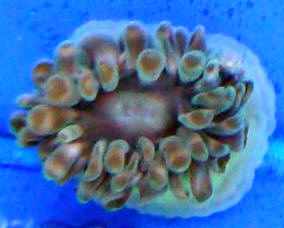
|
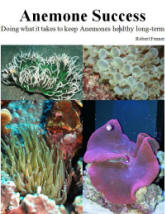 |
New Print and
eBook on Amazon:
Anemone Success
Doing what it takes to keep Anemones healthy long-term
by Robert (Bob) Fenner
|
| Turkish anemone ID and Velvetfish info
2/2/08 Hello Crew, <Felicia> Thank you for your
website. I go here every day, it is very helpful to me. <Ah,
good> I have been trying to ID this anemone for months. These
photos was taken by a friend in the Sea of Marmara. He asked me to
ID it, and I have no clue! Can you help? <I wish I had my copy
of Helmut Debelius "Mediterranean and Atlantic Invertebrate
Guide"... Do look for this work:
http://www.nhbs.com/mediterranean_and_atlantic_invertebrate_guide_tefno_131276.html
am pretty sure I've seen this distinctive pedicle before...>
And for your Velvetfish page, I thought you might like to post one
of my photos. This is my Caracanthus madagascariensis. <Thank
you for this. Will post with credit to you> He lives in my 55
gallon aquarium with some small gobies and pipefish and
miscellaneous inverts like corals, small crabs, and a squat
lobster. He hides constantly. I've heard they may eat small
fish, but he hasn't eaten anyone, yet. He is very easy to feed,
not picky, I feed Cyclops, mysis, etc. I don't feed pellets,
but I bet he would eat them. I'm definitely more careful about
where I put my hands, but I'm not overly worried that he will
sting me. Even though he rarely moves, I really enjoy watching him.
<Thank you for sharing. Bob Fenner> |
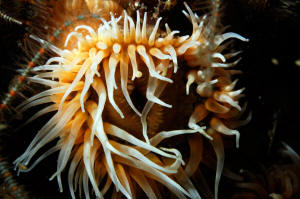 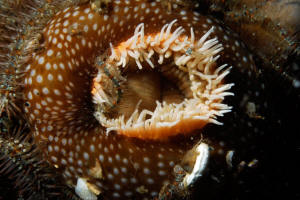 |
Anemone identification -01/29/2008 Hello, I
am trying to get identification on these anemones that came as
hitchhikers on live rock I purchased; they don't seem bothered
by light and close up when the lights are off. They appear to have
two rows of tentacles one row on the edge of the disc the second
more towards the center and perpendicular to the first row. They
are tan in color and the center is green in color. I apologize for
the quality of the picture it was taken with a laptop camera as the
digital camera I have provides less than desirable photos. At any
rate any help you could provide with identification would be
appreciated. <Pics are blurry, but they look like Aiptasia.
http://www.wetwebmedia.com/marine/inverts/cnidaria/anthozoa/Aiptasia/aiptasia.htm>
Regards
drafterdude
<Best,
Sara M.> |
|
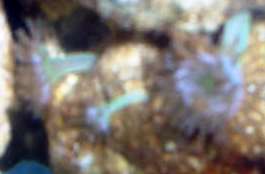
|
|
Anemone ID, E. Quadricolor or Majano -- 1/28/08 Hey guys!
<Hello, Brenda here!> This little guy came in on one of my
last shipments from Indo, possibly the last one. As I was
removing some polyp rocks from being dipped I noticed a few
polyps on the bottom of the pan so I just tossed them into the
tank, well apparently not all of them were Zoa polyps like I
thought. I was cleaning the glass with a mag glass scraper I
noticed what I thought was a Zoa polyp on the scraper inside the
tank. On closer inspection it appears to be an anemone. <It is
definitely an anemone.> It is green and purple with a bright
green foot; roughly 60 tentacles (don't remember which kinds
have what number of tentacles). <This anemone appears to be
starving. I can't be positive on the ID, but this anemone
does resemble a starving, roaming, E. quadricolor. It may also be
a Majano (pest) anemone. Both of these anemones have very similar
features. I would move to quarantine and feed very tiny portions
of food. Once this anemone recovers an ID will be much
easier.> Thanks, Phreak <You're welcome! Brenda>
Re: Anemone ID, E. Quadricolor or Majano -- 1/28/08 It
looks more like a green bubble tip then a quadricolor. <Green
bubble tip is one of the names commonly used for the E.
quadricolor. They are both the same species.> I forgot to
mention this thing is tiny, like the size of an ink pen. <I
have seen a few E. quadricolor anemones this size. However, there
is still a good possibility that you have a Majano anemone.
Brenda>
Re: Anemone ID, E. Quadricolor or Majano -- 1/28/08
I'm 90% sure it is not a Majano. <I hope it is an E.
Quadricolor. That would be a nice hitch hiker! Please send me an
updates on this anemone. Brenda>
Re: Anemone ID, E. Quadricolor or Majano -- 1/29/08
With it being so small, the only thing I can think of to feed it
is Cyclop-eeze... Any suggestions? <I recommend tearing off
the tiniest possible piece of silversides, krill or mysis shrimp,
and feed once daily. Brenda>
|
|
 .jpg)
My vote's on Anemonia. RMF.
|
| Re: Anemone ID, E. Quadricolor or Majano --
2/8/08 I've been feeding it Cyclop-eeze since its so tiny,
and here are pics I took today of it. <Mmm, needs more than
this. Please read here: http://wetwebmedia.com/anemonefdgfaqs.htm
and the linked files above. Bob Fenner |
|
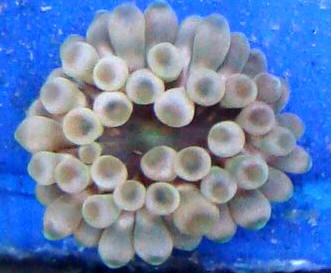 Anemonia Anemonia
|
| Powder Blue fdg., nitrates, anemone ID,
reading This is my first post to this site, and I thank you for
the help the information here had already provided. Had I found
this site a year ago, instead of relying on a lot of bad advice
from the LFS it would have saved many animals. I have three
questions which I've split into separate sections hoping this
makes it easier for you. First an intro to my tank Equipment
(Plan/hope to upgrade to 150+ gallon with wet/dry, refugium, MH/PC
lights, plenty of live rock, wavemaker, etc in 6 months as funds
allow) has been running for a year, first as FO, then FOWLR, now
moving very reefward, though we need to stop and catch up on
equipment 65 gallon with All Glass hood lights (only 30-40 watts, I
think); Fluval 304 with Bio-Max, carbon, Phos-Zorb and filter
floss; 40 lbs live rock, 55 lbs substrate (crushed coral, aragonite
sand, live sand), Prizm skimmer, 200W heater - will definitely add
powerhead(s) in next few days, may make other upgrades but will
likely save money towards better system and get my animals in there
ASAP Parameters: NH3 & NO2: undetectable for > 6 months, NO3
40-50 ppm (20-30 ppm from using conditioned tap water, switching
back to RO), <Good. NO3 issues are adequately addressed on
WWM> Ca 410 ppm, Alk 14 dKH, pH 8.3, salinity 1.025 (a little
too much fluctuation from evaporation here, will work to correct),
temp 77-8 F, 24 gallon changes every 2 weeks Livestock: 4"
Kole tang, 3" Powder blue tang, 2.5" Humu humu, 1"
flame Hawkfish, 3" Blenny (tentative ID as black or brown
Combtooth), 2x 3-Stripe damsels ~2", 11" Snowflake eel,
urchin (sold as Christmas urchin, though I can't find anything
similar - morphology similar to pincushion with purplish/brown body
and white and orange spines), assorted hermit crabs (~20, mostly
Clibanarius tricolor and Paguristes cadenati, but 1 each Dardanus
megistos, Clibanarius vittatus and dwarf yellow tip hermit),
Ophiarachna incrassata, serpent star (think it's still alive
somewhere, but missing most of its legs, suspect Dardanus
megistos), flame scallop (still alive after 10 months without
target feedings, and doubled in size), orange tree sponge, tube
anemone, Holothuria atra, 4 Nassarius snails, 2-3 limpets, and
several coral hitchhikers, including an open brain (did have a
period of decline, but not really improving or declining now) and
several mushrooms 1) My powder blue was a recent purchase, and I
knew I was taking a chance, since he was very thin, but he was
cheap so I decided to try. (I had really good luck with the last
three "bargain" tangs in my tank, a 4" yellow,
7" yellow and a 6" Regal, having cured Ich and HLLE in
all specimens, before failure of the Fluval's pump suffocated
all) After reading more on him, I realized just how much of a
challenge I had ahead of me. He's active and eating and has
gained some weight in the two weeks I've had him. Other than
algae sheets with Selcon and Zoë and Spirulina brine
shrimp, what can I do? <See WWM re New Life's
"Spectrum" fish food line> I know, finally a QUESTION
2) This was an interesting find: a conch shell with 6 anemones, two
small tubeworms and live barnacles. Trouble is the anemones were
sold as curlicues, which from comparison to other pictures online,
they are not. I was told they are nonphotosynthetic and just to
feed a small amount of whatever animal based food I was feeding the
fish (pellet, flake, frozen). Can you ID these guys, and give me
any insight as to their care? <Mmm, am out in Hawaii, away from
my in-print ref. works... but this species is "on the tip of
my tongue"... ARE non-photosynthetic, or at least
facultatively so... but can't recall much else re> They all
have an orange mouth, which on most is surrounded by a thin purple
ring. Also their colors didn't show up well in these pictures.
One has a darker purplish hue to the tentacles and another has
orangish tentacles. They are aggressive feeders of whatever drifts
to them, even taking large pieces of krill intended for the eel.
<I do hope BrendaF or LynnZ will respond in time re... Will
place in there in-folders> 3) Switching back to RO (got lazy
about packing 24 gallons at a time upstairs) should drop nitrates
by half, but I'd like to reduce them further. I have quite a
bit of nitrogen being produced in the sand bed, but not enough of
it comes to the surface. I attempt to rake the sandbed regularly,
but this is of marginal effectiveness at best. My Nassarius snails
have survived quite some time in the tank buried in the sand, but I
don't think they surface enough to really be effective. Seeing
as my wife is set on another porcupine puffer (one died 9 months
ago when heater was accidentally left unplugged after water change,
another during suffocation mass extinction) what do you suggest as
an animal that will provide good sifting to bring the deep nitrogen
to the surface? Thank you so much David <Read here:
http://wetwebmedia.com/marsiftfaqs.htm and the linked files above.
BobF> |
|
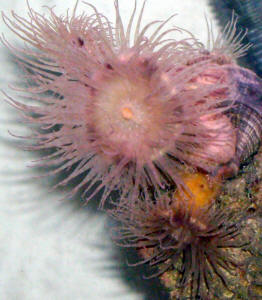
|
Re: Species List! and follow-up on Anemone ID
1/25/08 Thanks, Bob. Also, thanks for the
"Outstanding" comment yesterday - it made my day!
I really do enjoy the challenge that ID questions present .
Unfortunately, when it comes to anemones, I'm somewhat
lacking. I've been looking into the query you put in my
folder, and I really don't know what kind of anemones
those are. Brenda and I discussed them at length this
afternoon and she believes that they might be "Jeweled
Anemones", Corynactis spp. <Mmm... do look like
this genus in some respects...> For my part, I've
looked through every book I have, as well as all over the
internet and can't come up with anything that
"clicks". At first I thought that maybe they were
a Calliactis sp. - based on this photo:
http://www.meerwasser-lexikon.de/de/48/905/Calliactis/polypus.htm.
Then I thought they might be Nemanthus sp. , Amphianthus,
or even Dofleinia.. I just can't seem to pin it down.
I'm sorry I couldn't be of more help on this, but
if you know of a good resource book for anemones (for the
future), please let me know. I thought for sure those
anemones would be in the Baensch Atlas, but no such luck
(or at least I didn't recognize them). By the way, do
you want me to put that query back into the main marine
folder to give someone else a crack at it? <Methinks you
two are about our only shots...> Regarding the species
list, thanks, it's good to get this project off the
ground! By the way, I'm close to finishing up the algae
section, so once I do that and make a couple of corrections
(I forgot to put crustaceans under Arthropoda - duh!)
I'll send it on to you. Hopefully you'll have it
on/by Tuesday. At that point, I'll go ahead and send a
copy to Neale as well. I figured I'd hold off on that
until it was complete. Take care and have a great week in
sunny Hawaii! -Lynn <Thank you my friend. Cheers,
BobF>
Re: Powder Blue fdg., nitrates, anemone
ID, reading -- Brenda's Opinion 1/29/08 This is my
first post to this site, and I thank you for the help the
information here had already provided. Had I found this
site a year ago, instead of relying on a lot of bad advice
from the LFS it would have saved many animals. I have three
questions which I've split into separate sections
hoping this makes it easier for you. First an intro to my
tank Equipment (Plan/hope to upgrade to 150+ gallon with
wet/dry, refugium, MH/PC lights, plenty of live rock,
wavemaker, etc in 6 months as funds allow) has been running
for a year, first as FO, then FOWLR, now moving very
reefward, though we need to stop and catch up on equipment
65 gallon with All Glass hood lights (only 30-40 watts, I
think); Fluval 304 with Bio-Max, carbon, Phos-Zorb and
filter floss; 40 lbs live rock, 55 lbs substrate (crushed
coral, aragonite sand, live sand), Prizm skimmer, 200W
heater - will definitely add powerhead(s) in next few days,
may make other upgrades but will likely save money towards
better system and get my animals in there ASAP Parameters:
NH3 & NO2: undetectable for > 6 months, NO3 40-50
ppm (20-30 ppm from using conditioned tap water, switching
back to RO), <Good. NO3 issues are adequately addressed
on WWM> Ca 410 ppm, Alk 14 dKH, pH 8.3, salinity 1.025
(a little too much fluctuation from evaporation here, will
work to correct), temp 77-8 F, 24 gallon changes every 2
weeks Livestock: 4" Kole tang, 3" Powder blue
tang, 2.5" Humu humu, 1" flame Hawkfish, 3"
Blenny (tentative ID as black or brown Combtooth), 2x
3-Stripe damsels ~2", 11" Snowflake eel, urchin
(sold as Christmas urchin, though I can't find anything
similar - morphology similar to pincushion with
purplish/brown body and white and orange spines), assorted
hermit crabs (~20, mostly Clibanarius tricolor and
Paguristes cadenati, but 1 each Dardanus megistos,
Clibanarius vittatus and dwarf yellow tip hermit),
Ophiarachna incrassata, serpent star (think it's still
alive somewhere, but missing most of its legs, suspect
Dardanus megistos), flame scallop (still alive after 10
months without target feedings, and doubled in size),
orange tree sponge, tube anemone, Holothuria atra, 4
Nassarius snails, 2-3 limpets, and several coral
hitchhikers, including an open brain (did have a period of
decline, but not really improving or declining now) and
several mushrooms 1) My powder blue was a recent purchase,
and I knew I was taking a chance, since he was very thin,
but he was cheap so I decided to try. (I had really good
luck with the last three "bargain" tangs in my
tank, a 4" yellow, 7" yellow and a 6" Regal,
having cured Ich and HLLE in all specimens, before failure
of the Fluval's pump suffocated all) After reading more
on him, I realized just how much of a challenge I had ahead
of me. He's active and eating and has gained some
weight in the two weeks I've had him. Other than algae
sheets with Selcon and Zoë and Spirulina
brine shrimp, what can I do? <See WWM re New Life's
"Spectrum" fish food line> I know, finally a
QUESTION 2) This was an interesting find: a conch shell
with 6 anemones, two small tubeworms and live barnacles.
Trouble is the anemones were sold as curlicues, which from
comparison to other pictures online, they are not. I was
told they are nonphotosynthetic and just to feed a small
amount of whatever animal based food I was feeding the fish
(pellet, flake, frozen). Can you ID these guys, and give me
any insight as to their care? <Mmm, am out in Hawaii,
away from my in-print ref. works... but this species is
"on the tip of my tongue"... ARE
non-photosynthetic, or at least facultatively so... but
can't recall much else re> They all have an orange
mouth, which on most is surrounded by a thin purple ring.
Also their colors didn't show up well in these
pictures. One has a darker purplish hue to the tentacles
and another has orangish tentacles. They are aggressive
feeders of whatever drifts to them, even taking large
pieces of krill intended for the eel. <I do hope BrendaF
or LynnZ will respond in time re... Will place in there
in-folders> 3) Switching back to RO (got lazy about
packing 24 gallons at a time upstairs) should drop nitrates
by half, but I'd like to reduce them further. I have
quite a bit of nitrogen being produced in the sand bed, but
not enough of it comes to the surface. I attempt to rake
the sandbed regularly, but this is of marginal
effectiveness at best. My Nassarius snails have survived
quite some time in the tank buried in the sand, but I
don't think they surface enough to really be effective.
Seeing as my wife is set on another porcupine puffer (one
died 9 months ago when heater was accidentally left
unplugged after water change, another during suffocation
mass extinction) what do you suggest as an animal that will
provide good sifting to bring the deep nitrogen to the
surface? Thank you so much David <Read here:
http://wetwebmedia.com/marsiftfaqs.htm and the linked files
above. BobF> <<I'm not positive on the ID, but
I believe this may be a Corynactis viridis, commonly
referred to as a Jewel Anemone. Brenda>> >Thank
you Bren. BobF<
|
|
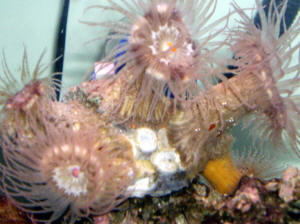
|
|
Anemone ID, Epicystis crucifer -- 1/18/08 Hi
there! <Hello, Brenda here!> I was wondering if you could
help me identify this anemone. <Sure can!> I've searched
and searched, on your website to, which is really awesome and
helpful. Thanks guys! <You're welcome!> I just can't
seem to find this one. <It is an Epicystis crucifer. It is
commonly referred to as a Rock Anemone, and/or a Flower Anemone.
More information found here:
http://www.wetwebmedia.com/marine/inverts/cnidaria/anthozoa/atl_anemfaqs.htm
> I've had him for little over a year now and everything was
going great, until he started moving. I don't know why or if he
could harm any of the others. <Do you mean other anemones? Mixed
species of anemones do not do well together long term.> For now
everything has gone fine, but I want to be sure. Help please. Thank
you in advance.
<You're welcome! Brenda> |
|
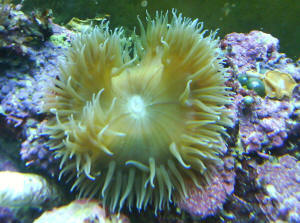
|
Unknown live rock ID... Looks Like Aiptasia
1/12/2008 Hi Bob and crew, <Hi Mark, Mich here apologizing
for the delay.> and season's greetings to you all. <Thank
you and to you and yours.> Firstly, congrats on a brilliant site
full of info. <On behalf of Bob and the crew you're quite
welcome.> I have attached a photo of an unknown critter?
<Looks like Aiptasia to me.> that has appeared on my live
rock. This thing does not move, however its legs? do sometimes pull
in on themselves. I have searched through you website, and various
others, but have not yet seen anything like it. The central body is
about 3mm in diameter. I would be very grateful if you could shed
light on it, and confirm it is a goody or baddy, <Does not look
like a friend to me.> as I am very new to this marine tank
malarkey and such. <Heehee! There is a lot of malarkey to
learn!> I assume it be friendly, as it does not appear to move
around the tank. <Well may be worth just observing but it does
look like a pest anemone to me.> Keep up the good work. <We
will try!> For info, I have a 94 litre tank, 2 Clowns (Nemo type
for Daughter) <I would recommend avoiding the addition of any
anemones until the tank is up and running for at least a year and
you have gained some experience as an aquarist.> 1 turbo snail,
3 hermit crabs, 1 cleaner shrimp and 2 small emerald crabs (LR
hitchhikers) <Watch these emerald crabs... can be predatory.>
Mark, United Kingdom.
<Mich, USA> |
|
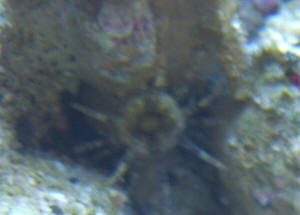
|
|
|

